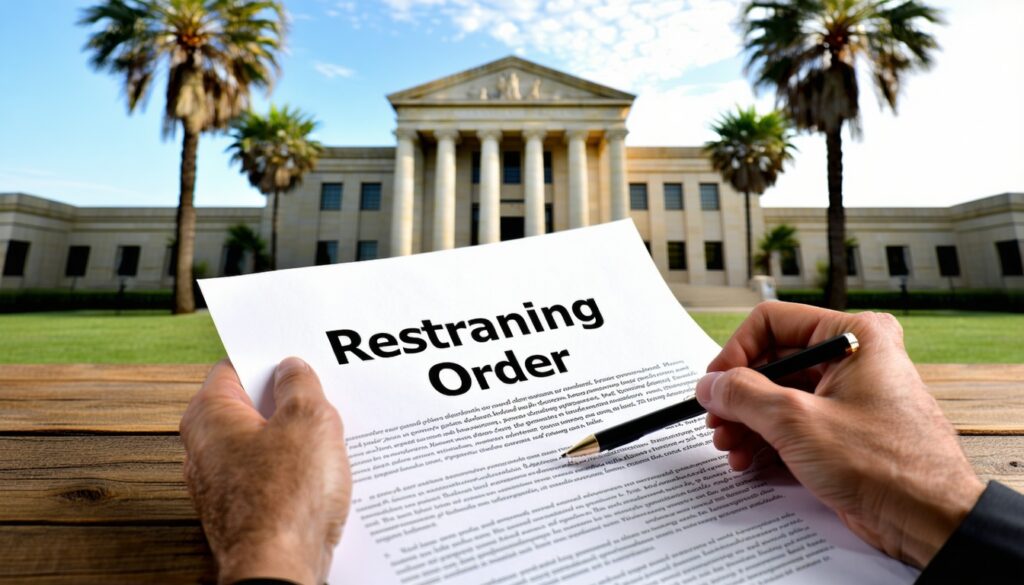
Living in California and facing a legal mess? Yeah, I get it—life can throw some unexpected curveballs. But hey, with Law Karma, you’re not alone in this legal whirlwind. If you’re thinking about filing a restraining order, we’ve got the playbook to make that process as painless as possible.
There’s a buffet of restraining orders out there—more choices than you’d guess. And knowing when to hit the “go” button can feel like finding a needle in a haystack. But fear not; with solid info and a clear roadmap, you’ll march into that legal office with the swagger of someone who’s got their ducks in a row.
We’ll lay out what you need to do, know, and keep in mind while filing for a restraining order in California. With Law Karma by your side, consider yourself armed with the knowledge to take charge of your situation. And if wondering who’s the right lawyer for you? We’ve got that solved too—setting you up with top-notch legal advice to ease the bumps along this tricky path.
Keeping your rights and security top-notch is the name of the game when you’re dealing with California’s legal labyrinth. Law Karma’s got the resources and savvy to untangle those complexities for you. Count on us; we’ve got the map to guide you towards a win, right to your case’s victory dance.
- What Is a Restraining Order in California
- When Should You File a Restraining Order
- Step-by-Step Guide to Filing a Restraining Order in California
- Proof and Evidence Needed to Support Your Case
- Costs and Fees Associated With Filing a Restraining Order
- Special Considerations
- What Happens If You Violate a Restraining Order
- Additional Resources and Support for Victims
- Frequently Asked Questions
What Is a Restraining Order in California
In sunny California, restraining orders are your legal shield against harassment, abuse, or any kind of unwelcome roughhousing. Knowing the various restraining orders can help you pick just the right armor for your situation.
Domestic Violence Restraining Orders
These orders are for folks dealing with abuse from someone they’ve cuddled with—past or present. It comes with perks like keeping the abuser out of your bubble, giving them the boot from your house, and sorting out who gets the kiddos temporarily. Good fences make good neighbors, and this order builds a sturdy one.
Civil Harassment Restraining Orders
If you’re being bugged by someone who’s not your “better half,” this is your go-to. Stalkers, neighbors, or that one guy at the office who won’t quit can be kept at bay. Think of it as a way to handle those who need a touch more social distance.
Elder or Dependent Adult Abuse Restraining Orders
Specifically crafted for our cherished seniors or folks needing a helping hand who are getting raw deals. Whether it’s neglect or some greedy fingers in the cookie jar, this order swoops in to level the justice field.
Workplace Violence Restraining Orders
Your 9-to-5 shouldn’t come with a side of fear. These orders ensure an annoying colleague or an uninvited guest stays out of the break room and away from your desk. Both employers and employees can make the call for this protective barrier.
Gun Violence Restraining Orders
Ever worry about someone pulling a wild West routine with firearms? Family, roomies, or the cops can use this order for a brief but crucial time-out on someone’s gun-slinging abilities to keep everyone safe and sound.
School Violence Restraining Orders
Whether it’s a classroom or the playground, everyone deserves a peaceful learning space. If anyone’s causing undue stress to students, teachers, or staff, this order steps in to reset the peace and quiet levels.
Emergency and Criminal Protective Orders
Sometimes you need a quick fix just when things hit the fan—here’s where these short-term lifesavers come in handy. The police can hand these out on the spot during crisis moments. On the flip side, criminal protective orders are served up by the courts to safeguard folks involved in criminal cases.
Mastering these different types of restraining orders helps you find the right legal sword in battles with harassment or violence. Got questions about getting a restraining order in the Golden State? Call up a legal eagle who can help guide your footsteps.
When Should You File a Restraining Order
Thinking about filing a restraining order in California isn’t exactly a walk in the park. You’ve got to know when it’s the right move, especially to keep yourself safe and sound. Here’s the lowdown on when you might consider this legal step and understand what’s considered harassment or abuse.
Common Grounds for Filing a Restraining Order
So, why would someone file a restraining order? It’s basically like a big “Stop Right There” sign for folks who pose a threat. In California, there are a few key reasons to hit the legal gas pedal:
- Someone’s making threats on your life or safety.
- You’re on the receiving end of nasty verbal or emotional jabs.
- You’ve got a shadow—someone keeps an eye on you—without being asked.
- You’re feeling scared or threatened by another person’s actions.
- You’re caught in the web of domestic violence.
If your safety and peace are being compromised, then it’s probably time to consider filing that restraining order.
What Qualifies as Harassment or Abuse
Harassment or abuse isn’t just about bruises and broken bones. It’s the ugly stuff you can’t see, too. If you’re seeking a restraining order, some behaviors might tick the box:
- That person won’t leave you alone–calls, texts, emails, you name it.
- They’re flinging verbal threats or trying to scare you.
- Gotten physical or shown aggression.
- You’re getting tailed or have an unwanted audience.
- They like pulling your strings–controlling your life in sneaky ways.
These behaviors can mess with your head, heart, and whole being. Understanding them is essential before you decide to take legal action.
If you’re tip-toeing around the idea of a restraining order in California, keep your well-being front and center. Chat with a lawyer who deals with this stuff—they can show you the ropes. Don’t forget, your safety isn’t something to gamble with, and getting help is a smart move to make sure you’re out of harm’s way.
If you’re in California and searching for legal assistance, Law Karma’s got your back. They can link you up with attorneys who know their way around restraining orders. Check out california accident lawyer for more information on protecting your rights.
Step-by-Step Guide to Filing a Restraining Order in California
Dealing with the whole restraining order thing in California ain’t as hard as it seems if you know what to do. Making sure you’re safe is top priority and breaking it down into steps will make the whole ordeal less of a headache.
Step 1 Get Those Forms
First things first, you gotta get the right forms from the court. You need these puppies to lay out why you’re seeking protection and spill the details on what’s been happening. Be thorough and precise – this is no time for sketchy details or half-truths.
Step 2 Fill ‘Em Out
Once you’ve got the forms in hand, tackle them with all the details you can muster. Recall every incident, every date, and time that these unsettling experiences went down. Paint a clear picture – this ain’t the time to be vague. The stronger your paperwork, the better chances you have in court.
Step 3 Time to File
With forms filled out, march them over to the right California court. Make sure you follow every bit of the court’s instructions to a T. They ain’t gonna wait around for you, so make sure you’ve dotted your Is and crossed your Ts.
Step 4 Delivery Time
The court decides if your request makes the cut, and if so, you gotta hand-deliver or serve that order. This isn’t a friendly note; you’re legally informing the other party about what’s up. Ensure it’s done correctly so the police can enforce it if necessary.
Step 5 Show Up for The Hearing
After you’ve dropped the news, usually, there’s a court hearing. This is where you layer on more evidence if you’ve got it, and make your case. Be ready and clued up on the court’s procedures because this is your chance to make sure the judge understands your situation.
Step 6 The Aftermath
Once all’s been said and done at the hearing, the judge will decide the fate of the restraining order. If you win, get to know each rule inside out. Breaking them won’t just look bad; it could be dangerous. Stay compliant to keep yourself protected.
So, follow these steps and get a lawyer if you need one. Your safety is what matters the most. Legal tips and nice folks can be found at Law Karma, making sure you get the help you need right here in California.
Proof and Evidence Needed to Support Your Case
If you’re looking to file a restraining order in California, you’ve got to come armed with some solid evidence. It’s not just about having a strong story but backing it up with proof that can sway the decision in your favor. Hang tight as we go through what you need to show you’re not crying wolf, how to lay out your case, and which documents and people can back you up.
What Counts as Good Evidence
Good evidence is anything that backs up your story about being harassed or threatened. Here are the heavy hitters you want to gather:
- Incident Reports: Every time the cops were involved, those reports could be your ticket to safety.
- Witness Statements: Get your friends, neighbors or anyone who’s seen or heard stuff to back you up.
- Communication Records: Texts, emails, or those late-night voicemails that didn’t sit right with you.
- Photographs: Snaps of bruises, wrecked doors, or any chaos left behind.
- Medical Records: Documentation of injuries you can pin on your harasser.
- Relevant Court Documents: Any old restraining order or other legal paperwork that’s part of your saga.
Cast a wide net and collect these, and your case is looking golden.
How to Prove Harassment or Abuse
Showcasing harassment or abuse isn’t as simple as just telling your story—you need receipts. Here’s how you hit the nail on the head:
- Document Everything: You need logs of every look, sneer, shove, and scream—dates, times, the whole nine yards.
- Gather Supporting Evidence: Scrape together all those emails, calls, snaps, and people willing to vouch for you.
- Maintain Consistency: Keep your story straight; contradictions can let the other side weasel out.
- Seek Professional Help: If you’ve got scars—psychological or physical—get a doc to note that down.
Consistency and clarity make your case a slam dunk.
Examples of Supporting Documents and Witnesses
The right documents and folks backing you up in court can shine a floodlight on the truth. Here’s what you should load up on:
| Type of Document | Description |
|---|---|
| Police Reports | Calls cops made, followed by paperwork you get to hold. |
| Medical Records | Bruises, breaks, and any doctor’s opinion. |
| Text Messages/Emails | Evidence of the dirt slingers making their moves. |
| Witness Statements | Words from those who’ve seen it, up close or far away. |
| Photos/Video Evidence | Physical proof—black and white or color—of the mess made. |
Stack these allies high. They’re the building blocks of your protection.
When it seems like you’re hitting roadblocks in getting a restraining order, Law Karma’s got your back. They can hook you up with seasoned attorneys who know the ropes and will fight for your corner. Need guidance? Pour your woes to them and let the experts arm you with legal strategies to keep you safe.
Costs and Fees Associated With Filing a Restraining Order
Thinking of getting a restraining order in California? Here’s some straight talk about costs and fees—save yourself some surprises down the road. I’ll break it down for you: how to go the no-cost route or get a fee break, and what you might be shelling out for a lawyer if you need one.
Can You File for Free or With a Fee Waiver
In the sunny state of California, folks wanting a restraining order might catch a break with free filing or a fee waiver if money’s tight. They’ll look at your cash flow, what you own, and how many mouths you’re feeding to decide if you get a pass on the fees. If coughing up dough isn’t an option for you, toss in a fee waiver request when you’re doing your paperwork.
| Fees for Filing a Restraining Order | Amount |
|---|---|
| Filing Fee | Changes with county (Could hit around $200) |
| Service of Process Fee | Changes (Around $50 – $75) |
| Fee Waiver | Up for grabs if you qualify |
Think you’re one of the lucky ones who could snag a fee waiver? Chat with the court staff or hit up a legal aid group to get the lowdown on how things work. And hey, if you’re curious about the nitty-gritty on filing that restraining order, check out our guide on how to file a restraining order in California.
Lawyer Costs and When You Need Legal Help
You might be flying solo when filing a restraining order, but lawyers can be lifesavers in sticky situations. They know the courtroom dance, can help gather dirt to back your case, and stand by you in front of a judge.
Hiring a lawyer doesn’t come with a one-size-fits-all price tag—depends on your mess and their fee plan. Some might throw out a flat rate for the whole circus, others might keep the meter running hourly. Chat payment and fees before signing on the dotted line.
Pondering whether to lawyer up? Think about:
- How tangled your situation is and what kind of order you’re gunning for.
- If you need advice on how to collect evidence and argue in court.
- Whether you can play the court game and know your rights without a lawyer.
There are resources galore out there, ready to link you with ace lawyers for restraining orders. Whether you go it alone or bring in the pros, getting a grip on the financial side and knowing where to turn for help sets you on the right path for tackling a restraining order in California.
Special Considerations
Let’s dive into the ins and outs of filing a restraining order in California. There are several key elements that can make this process smoother and more effective. Knowing these little intricacies helps you deal with the system in a clear and confident way.
Can You File a Restraining Order Online in California
Californians, listen up! In certain counties, you can start a restraining order online. This nifty feature lets you get the ball rolling right from your couch. But here’s a heads-up: not every county is tech-savvy. Make sure to check with your local courthouse to see if they offer this digital convenience in your area.
What to Do If the Judge Denies Your Request
Bummer! If a judge says no to your restraining order, don’t throw in the towel just yet. It’s time to wheel in a legal eagle. A lawyer can help you figure out what went sideways and suggest your next move. You can file an appeal or ask for another look at your petition. Pinpointing the weak spots in your initial application might just turn things around for you.
Filing a Counter Restraining Order
Picture this: you’ve been slapped with a restraining order and think it’s all baloney. What to do? First, breathe. Then consult a top-notch lawyer who can guide you through the legal maze to defend yourself. Knowing your rights and options is paramount when you’re hit with a counter restraining order.
How Long Does a Restraining Order Last
So, how long are these orders sticking around? In California, it depends. Temporary restraining orders usually last until the court hearing, so don’t get too cozy. When it comes to permanent ones, they could last several years, or even indefinitely, all depending on the specifics of the case. It’s like a box of chocolates: you never know what you’re gonna get.
Maximum Distance and Other Restrictions Imposed
One last thing: restraining orders can tell you how far to stay away from the person who got it against you. They set these buffers to make sure everyone’s safe and sound. Also, these orders might tell you to stop all the WhatsApp, Instagram, and Snapchats. Complying with these rules is key to staying out of hot water.
Now, keep a level head and be smart about it. Legal paths are crowded and bumpy; knowing how to steer surely gets you there a lot easier.
What Happens If You Violate a Restraining Order
Messing up with a restraining order in California isn’t just a slap on the wrist; it’s serious business. Knowing what’s at stake if you don’t follow the rules is super important.
Legal Consequences for Violators
Break that order, and you’re looking at fines, maybe some time behind bars, or both. How deep you get into trouble depends on how badly the order was broken and your track record. Get hit with contempt of court, and now you’re talking criminal charges.
| Violation Type | Payback Time |
|---|---|
| Ping the Person Shielded | Fines, Lock-Up |
| Near the No-Go Zone | Community Work, Probation |
| Hassling or Threatening the Person | Stretch or Tweak the Order |
| Fisticuffs | Criminal Case, Cuffs |
Stick to what’s spelled out in the restraining order. If you’re scratching your head about what you can or can’t do, don’t sit on it. Find a lawyer who knows their stuff to steer you through this legal maze so you know what’s what.
How to Report Violations
Feel like the order got crossed? Act fast. Keeping yourself safe and making sure the one who messed up pays is the goal. Here’s the game plan for blowing the whistle on a restraining order slip-up in California:
Log the Mess-Up: Jot down all the nitty-gritty details—dates, times, and any proof like texts or voicemails. Eyewitness accounts? Gold.
Ring the Cops: Dial up the local police or the sheriff. Hand over all your gathered evidence so they can take action.
Dial a Lawyer: An attorney who gets restraining orders is your best bet. They’ll help you figure out what to do next.
Show Up in Court: If the gavel’s coming down in court, be there. Tell your side—it matters a ton for making sure the rule-breaker’s called out.
By stepping up and flagging any order breaches, you’re not just protecting yourself but making sure justice gets done. Your safety is front and center; getting some backup from the law is key when these situations pop up.
Additional Resources and Support for Victims
So you’re in a tough spot, huh? Handling legal headaches or tangled issues can feel like being caught in a rainstorm with no umbrella. But you don’t have to endure it solo, especially if you’re in California. There are plenty of folks out there who want to help. Two big players in your support team are knowing your rights and finding the right posse—support groups and legal aid superheroes.
Victims’ Rights and Available Help
If you’ve faced harassment, abuse, or any other kind of nastiness, you’ve got rights to protect you and help you get justice. Knowing what these rights are can turn a confusing legal maze into a path you can walk with confidence. We’re talking about things like staying safe, keeping your life private, and pursuing the jerks who’ve wronged you.
California’s got your back. There are squads dedicated to helping folks in sticky situations. Imagining dealing with legal jargon without needing a translator or standing up in court with someone right by your side, who’s totally got your back. All these are possible with the right help.
Once you get the lowdown on your rights and find out who’s out there ready to support you, you can take control of your situation. It’s like having a flashlight in that dark tunnel, ready to guide you to the other side.
Support Groups and Legal Aid
Taking on legal stuff can feel like a never-ending rollercoaster, but trust me, it doesn’t have to make you queasy. Support groups and legal aid services are like your personal pit crew. They’re there to tune you up emotionally and give you a roadmap for navigating the legal jungle.
Support groups are where the magic of shared experiences happens. You meet people who get it, share stories, and help pick each other up when things get heavy. It’s a safe haven for swapping tales, getting a hug (virtual or otherwise), and finding a bit of peace. You’ll find strength in numbers, and those numbers are on your side.
Legal aid services are the legal lifeline when private representation is out of reach. They cut through the bureaucratic red tape, help you with paperwork, and translate the legal mumbo-jumbo into something you can actually understand. It’s like having a legal GPS leading you through the twists and turns.
Connect with a support network and legal aid, and you’ve got a toolkit to address any legal curveball thrown your way. Having these folks on your team can turn stress into resolve, arming you to tackle whatever challenge lies ahead.
For the scoop on all things legal, check out Law Karma. They’ve got the connections to match you with the right legal minds who can offer advice tailored to what you’re going through.
Facing legal storms or needing advice about victims’ rights in California? Law Karma’s got the goods to help you weather the storm and come out stronger. Hit them up today for the support and resources that might just change your life.
Frequently Asked Questions
Let’s tackle some of those burning questions about filing for a restraining order in California.
What Proof Do You Need for a Restraining Order in California
To get a restraining order in California, you gotta bring the receipts— literally. Gather whatever you’ve got like photos, texts, emails, witness accounts, or other stuff that shows you’re in need of protection. The more you can lay out, the better chance you’ve got.
How Fast Can You Get a Restraining Order
Timing can be a wild card. If things are hairy and you need protection pronto, you can file for an emergency order. This temporary shield buys time until a more formal hearing happens. Generally, within a few days to a couple of weeks of filing, you can expect an answer, depending on how the court’s calendar looks.
What Are the Requirements to Get a Restraining Order
You’re gonna need to prove you’re dealing with harassment, stalking, abuse, or violence. Show the court evidence of the other person’s actions and the danger they pose to you. Make sure all the paperwork is sorted out and be ready to present your side during the hearing.
Can I Change or Cancel a Restraining Order
Things change, right? If the situation shifts and you want to tweak or end a restraining order, submit your request at the court. Explain why, maybe things cooled down or you patched things up. The court will weigh your reasons and make the call.
Can You File Without a Lawyer
Yup, you can file solo, but having a lawyer can really help with dotting those i’s and crossing the t’s. They’ll guide you through the process, help with evidence, and back you up in court if necessary. If you go it alone, make sure you’re clear on what to do and where to get help.
What Happens After a Restraining Order Expires
Once the restraining order’s clock runs out, so do its protections. Take a minute to think. If you still need to keep someone at arm’s length, look into renewing before it lapses. Depending on your case, it might be worth getting some legal advice about extending it.
If any questions are still buzzing around or you need a hand with filing or other legal stuff, Law Karma connects you with the right lawyer to help you steer through the process.






